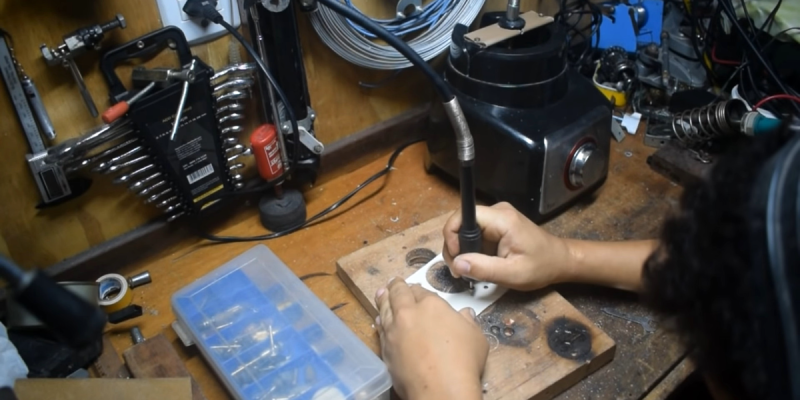[Leandro Felipe] is no stranger to the dirty hack, and this video of his conversion of a blender into a handheld rotary grinding tool is no exception. (Embedded below.) But the end result is something pretty useful — a lighter and more maneuverable rotary grinder that’s got a lot more grunt to boot.
(The video is in Portuguese, but the captions work pretty well, once you get over the fact that the robots translate “grinding tool” as “rectifier” a lot of the time. And anyway, you’re here for the hacks.)
The highlights are a handmade coupling that mates the blender motor with the flexible shaft and chuck, purchased separately. And the flattened-out PVC pipe used as a mounting bracket. And him using the motor itself against a file to “lathe” down the drive shaft. And…
The tip of the day comes when he holds the blender motor in a metal vise to test it out. Metal and spinning magnets — what’s the worst that could happen? Sparks, smoke, and a trip to the thrift store for another used blender.
If you just want to see the finished piece, you can jump ahead to the end. But it’s basically, get yourself a speed-adjustable blender, couple it to the shaft of an off-the shelf grinder, and you’re set.
It’s an idea so conceptually easy, you might wonder if Hackaday has ever showcased a blender dr3mel before. We have. What else can you power with a blender motor?
Thanks [Danjovic] for the tip!
















Keep in mind that using grindr can sometimes be a dirty business. It’s a good idea to wear protection.
Well, it depends whether you want to do 3D modeling or to f*** :-D
Was looking for this comment so I can upvote it. No like button here? Is throw even internet?
love your title
Now that is a hack, not quite an angle grinder that can make a daiquiri but still pretty good! Also if you have a whole blender (bought used, found on the garbage) I think it would make more sense to modify the container of the blender (what you put the stuff in) so you don’t have to take the blender motor housing apart, just use the container/motor interface that is already built in.
I bought a used blender ($3) and tried to use it to “de-gel” naval jelly that was too thick to brush on. The results were poor. Maybe it needed something to thin it, but I didn’t know what.
Well Ma Google says…
What is Naval Jelly made of?
Naval Jelly contains Water (65-70%), acid phosphoric acid (25-30%) and acid sulfuric acid (1-3%) in a gel matrix composed of a thixotropic polysaccharide (1-3%), alcohol isopropanol (1-3%), Surfactant (1-3%) and Silica (0.1-1%)
So maybe put some water in the blender, some thick jelly and give it a blend.
Thanks!
He needed to reverse the rotation of the motor to match the rotation to the cable shaft… I guess it wouldn’t work on the motor axis shaft without more reworking… Not sure if there is a way to reverse the motor rotation changing some of the wiring…
There is a tool jewelers often use called a Foredom: a flexible shaft motor and handpiece somewhat like this. What they do that’s pretty useful is design it to be used with the base upside-down, hanging above you from a hook or the ceiling. That really makes it easier to maneuver and frees up some bench space.
sorry, I can’t stand maker who feel the need to act like a comic.
YouTube is a plague!
I have never heard a blender that I could stand to be in the room with. I appreciate the repurposing of the blender motor, but maybe there are other ways to achieve this and preserve your hearing/sanity.